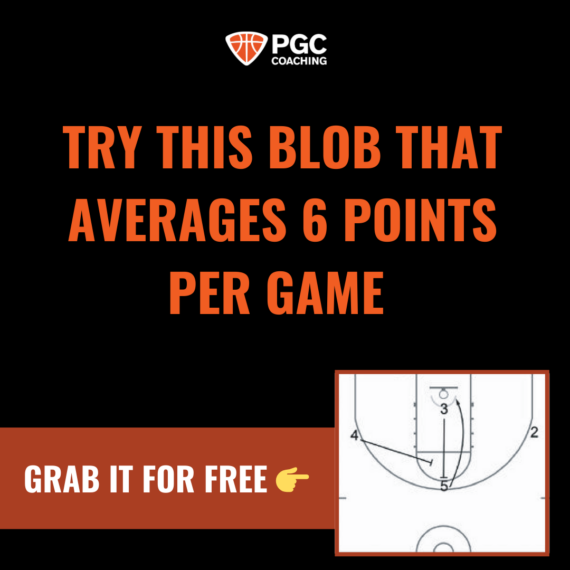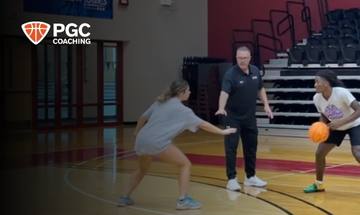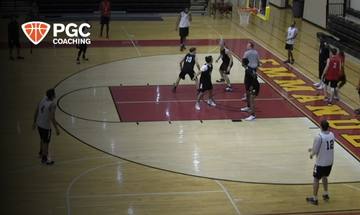Smarter Closeouts: How to Defend Shooters, Drivers, & Complete Players
Most coaches teach one kind of basketball closeout.
But here’s the truth—not every offensive player should be closed out the same way.
If your players treat shooters, non-shooters, and complete players the same, you’re giving away easy points.
That’s where Assignment Closeouts come in.
This drill helps your team master three types of basketball closeouts based on who they’re guarding. And it’s one of the most game-transferable ways to teach defensive IQ.
By the end of this drill, players will be able to identify the type of player and closeout they need to make in order to stop the offense in their tracks…
And if you’re interested in more tools (what coach isn’t, right?) here are a few more you might want to check out after this…
- 5 Game-Like Shooting Drills to Build Confident, Consistent Scorers
- Why I Spent 12 Straight Practices on the Read & React (and Didn’t Teach Defense)
- Competitive Basketball Drills to Build Game-Ready Teams
Alright–without further ado, let’s dive in…
Basketball Closeout #1: The Non-Shooter
You know the player. They don’t want to shoot. They’re looking to put the ball on the floor and drive it.
How to close out:
- Sprint about 50% of the way
- Break down early (around the 75% mark)
- Give them space to bait the shot
- Stay down, stay solid
Why it matters:
This defensive closeout keeps your defender from biting on fakes or getting beat by speed. It says, “If you want to shoot it, go ahead.”
Basketball Closeout #2: The Shooter
Every team has one. The kid who can let it fly from deep with confidence.
How to close out:
- Sprint 90% of the way
- High hands directly into their shot pocket
- Don’t worry if you get beat off the dribble
- The priority is: Don’t let them get the shot off
Why it matters:
Shooters can’t get comfortable. This defensive closeout disrupts their rhythm and takes away their superpower.
Basketball Closeout #3: The Complete Player
These are the toughest players to guard, which is why great coaches communicate scouting reports.
How to close out:
- Sprint 75% of the way
- High hands to take away the shot
- Break down under control to defend the drive
- Be ready to move your feet and absorb contact
Why it matters:
Against a player who can shoot and drive, your defenders have to expertly close out and rely on solid footwork and other players’ help behind them.
How the Basketball Closeout Drill Works
- Set up players on the perimeter
- Coach calls out the type of player (Driver, Shooter, or Complete Player)
- Defender executes the corresponding defensive closeout
- Reps happen quickly and continuously
- Players rotate through all three defensive closeout types
This not only builds muscle memory, but it also sharpens awareness. Your players learn to process who they’re guarding and how to adjust accordingly.
Teach Defense with IQ
Coaches often ask, “How do I get my players to play smarter on defense?”
Start here. Give them context. Teach them to defend based on the assignment.
When your players know the scout and adjust their defensive closeouts, you stop giving away threes. You stop overhelping on non-shooters. You stop putting your defense in rotation.
You win more possessions and more games.
Watch the Assignment Basketball Closeout Drill Video
FAQ: Assignment Closeouts – Train Smarter Basketball Closeout Techniques
These FAQs will help you refine your players’ understanding of how to close out against different types of offensive threats and build high-IQ, adaptable defenders.
Q: What are assignment closeouts in basketball defense?
A: Assignment closeouts are customized defensive closeouts based on the offensive player’s skill set. Rather than using a one-size-fits-all closeout, defenders adjust based on whether their matchup is a:
- Non-Shooter (drive-first player)
- Shooter (high-percentage perimeter threat)
- Complete Player (can shoot and drive)
This strategy improves defensive efficiency by closing out with purpose and minimizing over-help and blown rotations.
Start training assignment closeouts to build smarter defenders who know their matchups.
Q: How should defenders close out on non-shooters?
A: Against a non-shooter:
- Sprint only halfway
- Break down early to control their drive
- Stay low and wide, hands out
- Give cushion to invite a low-percentage shot
This closeout baits the offense into less efficient decisions without overcommitting.
Reinforce this closeout to stop drive-first players from collapsing your defense.
Q: What’s the best way to close out on a shooter?
A: For shooters:
- Sprint 90% of the way
- Get hands up high into their shot window
- Prioritize disrupting the jumper over preventing the drive
- Land under control but aggressively contest
The goal is to take away their comfort and rhythm—don’t let them get the shot off.
Train this closeout consistently to neutralize your opponent’s best perimeter threats.
Q: How do you close out on a complete offensive player?
A: Against a complete player:
- Sprint about 75% of the distance
- Use high hands to contest the shot
- Break down under control to prevent the drive
- Be prepared to slide and absorb contact
This closeout balances shot pressure and drive containment, relying on disciplined footwork and defensive support.
Practice this type of closeout to challenge your opponents’ most versatile scorers.
Q: How does the assignment closeout drill work in practice?
A: Set up players on the perimeter with defenders ready. The coach calls out the matchup type (“Shooter,” “Driver,” or “Complete”). The defender must:
- React instantly
- Execute the corresponding closeout
- Reset quickly for the next call
Players rotate so everyone practices closing out against all three offensive types.
Run quick, high-rep sequences to develop instinctive, matchup-based closeouts.
Q: Why are matchup-based closeouts important?
A: They’re important because they…
- Reduce unnecessary help rotations
- Prevent open shots or easy drives
- Build player awareness and adaptability
- Help defenders anticipate instead of react
This approach moves your defense from reactive to intentional and efficient.
Adopt assignment closeouts to minimize breakdowns and elevate team defense.
Q: How do you build muscle memory for smarter closeouts?
A: Use frequent reps with verbal cues. For example:
- “Shooter!” → aggressive sprint and hand-up contest
- “Driver!” → breakdown early and contain
- “Complete!” → controlled sprint and dynamic footwork
Players begin processing the scout + action connection through repetition.
Incorporate this into daily drills and scrimmages to build automatic closeout decisions.
Q: Can assignment closeouts be taught to younger or less experienced players?
A: Yes. Simplify by using:
- Two categories instead of three (e.g., Shooter vs. Driver)
- Colored jerseys or cones to represent matchups
- Slowed-down reps with feedback
Once players grasp the concept, increase tempo and complexity.
Tailor the drill to your team’s level, then scale it up as their IQ improves.
Q: Where can I learn more techniques to build smarter defenders?
A: Join the PGC Coaching Community to access:
- Defensive breakdown drills
- Matchup-based training progressions
- Game-tested strategies to improve team defense
Your first 7 days are free—explore the full curriculum and community insights.
Sign up for a free trial of the PGC Coaching Community and start building better defenders today.
Teach Closeouts with Purpose, Not Just Hustle
Assignment closeouts give your players a framework for decision-making on defense. When you teach your team to identify matchups and close out accordingly, you stop giving away easy points—and you start getting critical stops when they matter most.
And if you’re interested in speeding things up. Try our free 7-day trial and get access to member-exclusive defensive drills, resources, and strategies.
– TJ
Check out all of our defensive drills and strategy resources here.
About the Author
TJ Rosene
Coach TJ Rosene, head coach of the Emmanuel University men’s basketball team and Director of Coach Development for PGC Coaching, has spent his career shaping young athletes both on and off the court. With over 400 career wins and 12 seasons of 20+ wins, Rosene’s coaching experience is extensive and impressive. His teams have competed in six national championship games, winning three NCCAA National Championships. Under his leadership, the Lions made their NCAA Division II debut in 2018-19 and quickly captured two season titles and one tournament title, along with an appearance in the NCAA Division II Sweet 16 in 2021.
Rosene’s success expands far beyond the scoreboard. He’s been named National Coach of the Year three times and Conference Carolinas Coach of the Year twice. But for Coach Rosene, the most meaningful part of his work is the lasting impact he has on his players’ lives. As he puts it, “Coaching is a rare opportunity to shape and mold the lives of young people. It’s a privilege that I never take for granted.”
New Here?
Get coaching tips and tools like these delivered to your inbox each week!
Join the 15,000 coaches we’ve assisted…

Related Articles
How to Teach On-Ball Defense That Actually Works in Games
Build lockdown defenders with 5 simple on-ball habits every coach needs to teach. Start winning more defensive battles today!
45 Scramble Down: Build Defensive Communication, Rotations, & Recovery in One High-Impact Drill
Master defensive chaos with the 45 Scramble Down Drill — boost your team’s communication, quick rotations, and clutch stops under pressure. Ready to take your defense to the next level?
Competitive 4-on-4 Basketball Drill to Build Decision-Making, Shot Selection, & Defensive Grit
Train like you play. This 4-on-4 drill builds real-game toughness, smart decisions, and winning habits—every possession counts.
About PGC
PGC Basketball provides intense, no-nonsense basketball training for players and coaches. Our basketball camps are designed to teach players of all positions to play smart basketball, be coaches on the court, and be leaders in practices, games and in everyday life.
We combine our unique PGC culture with a variety of teaching methods and learning environments to maximize the learning potential of those that attend our sessions. In addition to spending 6-7 hours on the court each day, lessons will be reinforced through classroom sessions and video analysis.
Our goal at PGC is to empower you with the tools to fulfill your basketball dreams, while also assisting you in experiencing the joy of the journey.
To learn more about PGC Basketball, including additional basketball training tips and videos, visit our YouTube Channel or find us on Facebook, Instagram, and Twitter.






Share This Post